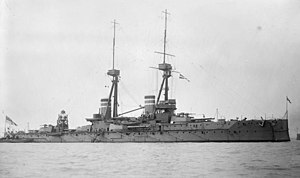HMS Temeraire (1907)

Temeraire at anchor, 1909
|
|
| History | |
|---|---|
|
|
|
| Name: | Temeraire |
| Namesake: | A captured French ship of the line |
| Ordered: | 30 October 1906 |
| Builder: | HM Dockyard, Devonport |
| Laid down: | 1 January 1907 |
| Launched: | 24 August 1907 |
| Completed: | May 1909 |
| Commissioned: | 15 May 1909 |
| Decommissioned: | 1921 |
| Fate: | Sold for scrap, 7 December 1921 |
| General characteristics (as built) | |
| Class and type: | Bellerophon-class dreadnought battleship |
| Displacement: | 18,596 long tons (18,894 t) (normal) |
| Length: | 526 ft (160.3 m) (o/a) |
| Beam: | 82 ft 6 in (25.1 m) |
| Draught: | 27 ft (8.2 m) |
| Installed power: |
|
| Propulsion: | 4 × shafts; 2 × steam turbine sets |
| Speed: | 21 knots (39 km/h; 24 mph) |
| Range: | 5,720 nmi (10,590 km; 6,580 mi) at 10 knots (19 km/h; 12 mph) |
| Complement: | 681–729 |
| Armament: |
|
| Armour: | |
HMS Temeraire was one of three Bellerophon-class dreadnought battleships built for the Royal Navy in the first decade of the 20th century. She spent almost her whole career assigned to the Home and Grand Fleets. Aside from participating in the Battle of Jutland in May 1916 and the inconclusive Action of 19 August, her service during World War I generally consisted of routine patrols and training in the North Sea.
Temeraire was transferred to the Mediterranean Fleet in October 1918 and she supported Allied forces in the Mediterranean and the Black Sea after the war ended in November. The ship was deemed obsolete and was reduced to reserve when she returned home in early 1919 and was then used as a training ship. Temeraire was sold for scrap in 1921 and broken up the following year.
The design of the Bellerophon class was derived from that of the revolutionary battleship HMS Dreadnought, with a slight increase in size, armour and a more powerful secondary armament.Temeraire had an overall length of 526 feet (160.3 m), a beam of 82 feet 6 inches (25.1 m), and a normal draught of 27 feet (8.2 m). She displaced 18,596 long tons (18,894 t) at normal load and 22,359 long tons (22,718 t) at deep load. In 1909 her crew numbered 681 officers and ratings and 729 in 1911.
...
Wikipedia
